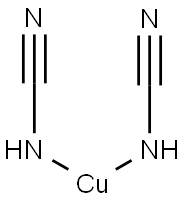A0999250
Coppercyanide , 99% , 544-92-3
Synonym(s):
Copper(I) cyanide;Cupricin;Cuprous cyanide
CAS NO.:544-92-3
Empirical Formula: CCuN
Molecular Weight: 89.56
MDL number: MFCD00010975
EINECS: 208-883-6
Update time: 2022-07-08
PRODUCT Properties
| Melting point: | 474 °C(lit.) |
| Boiling point: | decomposes [STR93] |
| Density | 2.92 g/mL at 25 °C(lit.) |
| bulk density | 750kg/m3 |
| vapor pressure | 0Pa at 25℃ |
| storage temp. | Poison room |
| solubility | insoluble in H2O, ethanol; soluble in KCN solution |
| form | Powder |
| Specific Gravity | 2.92 |
| color | White-beige to greenish |
| Water Solubility | Practically insoluble in water and alcohol. Soluble in ammonium hydroxide, aqueous ammonia, pyridine and N-methylpyrrolidone. |
| Sensitive | air sensitive |
| Merck | 14,2661 |
| BRN | 3587244 |
| Solubility Product Constant (Ksp) | pKsp: 19.46 |
| Exposure limits | TLV-TWA 1 mg Cu/m3 (ACGIH). |
| Stability: | Stable. Incompatible with acids, bases, magnesium. Reacts violently with oxidizing agents, nitrates. Reaction with acid releases highly toxic gas (HCN). |
| LogP | -1.49 at 25℃ |
| CAS DataBase Reference | 544-92-3(CAS DataBase Reference) |
| EPA Substance Registry System | Copper(I) cyanide (544-92-3) |
Description and Uses
off-white to green powder. Insoluble in water,soluble in HCI, Nl40H, and potassium cyanide. Used in Sandmeyer's reaction to synthesize aryl cyanides. Toxic by skin absorption, through open wounds, by ingestion, and by inhalation of hydrogen cyanide that arises from slight decomposition. Produces toxic oxides of nitrogen in fires.
Cuprous cyanide is used in electroplating; as an insecticide and fungicide; and as a catalyst for polymerization.
Safety
| Symbol(GHS) |   GHS06,GHS09 |
| Signal word | Danger |
| Hazard statements | H300+H310+H330-H410 |
| Precautionary statements | P260-P262-P273-P280-P302+P352+P310-P304+P340+P310 |
| Hazard Codes | T+,N,T |
| Risk Statements | 26/27/28-32-50/53 |
| Safety Statements | 7-28-29-45-60-61-28A |
| RIDADR | UN 1587 6.1/PG 2 |
| WGK Germany | 2 |
| RTECS | GL7150000 |
| F | 10-23 |
| TSCA | Yes |
| HS Code | 2837 19 00 |
| HazardClass | 6.1 |
| PackingGroup | II |
| Hazardous Substances Data | 544-92-3(Hazardous Substances Data) |





